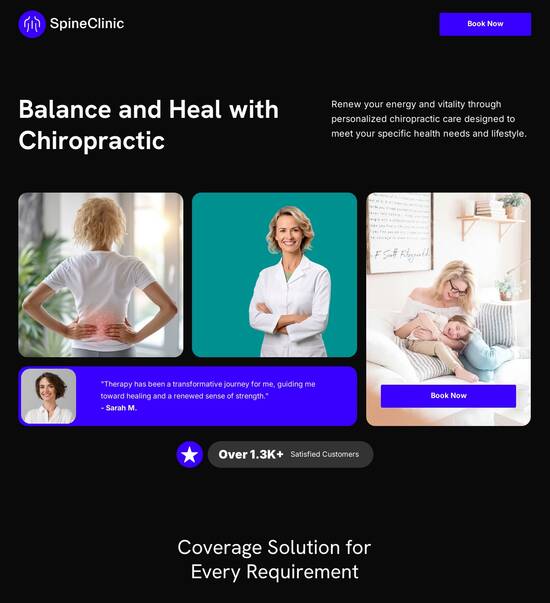
HTML page template with interactive survey form
Explore Similar TemplatesAbout template
Use HTML page templates with interactive survey form and make your communications easy and transparent. Try our solution today.
Recommended templates

Easy to build without coding
With the intuitive drag-and-drop builder, anyone on your team can create high-converting pages without any knowledge of code or design. Make enhancements to your landing page with custom widgets using Javascript, HTML/CSS, or third-party scripts.

Multiple layouts for any industry and goal
Select from 500+ landing page layouts built to boost conversions across industry-specific scenarios. Customize them by adjusting fonts, adding images, and generating on-brand content with the AI assistant. Quickly scale with Instablocks® and Global Blocks that you can save, reuse, and update globally.

Loads fast and looks polished on any device
Every template is responsive, which means they present professionally on any device and load blazingly fast with our Thor Render Engine. You can also power them up with Google AMP technology to deliver an unparalleled mobile experience and drive higher conversions.

Robust analytics & experimentation
Get real-time updates and reporting across all your devices, showing the number of visitors, conversions, cost-per-visitor, and cost-per-lead. Launch AI-powered experiments, run A/B tests, and use heatmaps to analyze user behavior, then optimize your landing page to maximize conversions.







Easy to build without coding
With the intuitive drag-and-drop builder, anyone on your team can create high-converting pages without any knowledge of code or design. Make enhancements to your landing page with custom widgets using Javascript, HTML/CSS, or third-party scripts.
Multiple layouts for any industry and goal
Select from 500+ landing page layouts built to boost conversions across industry-specific scenarios. Customize them by adjusting fonts, adding images, and generating on-brand content with the AI assistant. Quickly scale with Instablocks® and Global Blocks that you can save, reuse, and update globally.
Loads fast and looks polished on any device
Every template is responsive, which means they present professionally on any device and load blazingly fast with our Thor Render Engine.
Robust analytics & experimentation
Get real-time updates and reporting across all your devices, showing the number of visitors, conversions, cost-per-visitor, and cost-per-lead. Launch AI-powered experiments, run A/B tests, and use heatmaps to analyze user behavior, then optimize your landing page to maximize conversions.
All the features you need to build build a survey form html
Explore more featuresLearn how to build survey form template html
Frequently asked questions about survey website template html
Leading the way in building high-performing landing pages





Survey template html: Your ultimate how-to guide
Maximizing ROI for your digital marketing campaigns starts by harnessing the power of Instapage’s landing page and conversion rate optimization (CRO) tools. This guide will walk you through the essential steps to create effective landing pages designed to convert visitors into customers, tailored for diverse industries including business services, education, and tech.
Understanding the Key Features of Instapage
Instapage offers a robust array of features that cater to marketers in various verticals such as financial services, government, and education. Key functionalities include access to over 100 customizable templates, built-in experimentation tools, and detailed analytics to drive performance.
- Templates & Lead Gen Elements: Instapage provides a library of high-converting templates and customizable lead generation elements.
- Landing Pages: No coding skills? No problem. Build landing pages swiftly with user-friendly tools that don’t require developer expertise.
- Optimization: Utilize A/B testing and heatmaps to gain insights into customer behavior and refine your pages for higher conversions.
Step 1: Designing Your Landing Page
Start by selecting an appropriate template from Instapage's extensive library. Consider your target audience and the specific conversion goal you want to achieve.
- Choose a template that aligns with your branding for consistency.
- Utilize high-quality visuals that resonate with your audience, enhancing engagement.
- Ensure your call-to-action (CTA) stands out to drive conversions.
Step 2: Personalizing Content for Your Audience
Personalization is crucial for effective landing pages. Instapage's dynamic text replacement and AdMaps allow you to customize content for different audience segments.
- Use personalized headlines to connect with potential customers.
- Implement dynamic content that reflects user behavior or demographics.
- Track audience-level metrics to refine your strategy continually.
Step 3: Optimizing and Analyzing Performance
Once your landing page is live, it's essential to monitor its performance. Leverage Instapage's analytics dashboard to gather insights and optimize further.
- Conduct A/B tests on various elements (headlines, CTAs) to identify top performers.
- Analyze heatmaps to see where users engage most on your page.
- Continually refine your content based on metric insights to maximize conversions.
By following these steps, you can create effective landing pages that not only attract visitors but also convert them into leads and customers, ensuring a higher return on investment.
Ready to take your digital marketing campaigns to the next level? Sign up for Instapage today and start building landing pages that deliver results.
People also ask about html questionnaire template
Unveiling the Magic of HTML Page Templates with Interactive Survey Forms
Harnessing the power of interactive surveys on your landing page
Interactive content, like surveys, has become a pivotal player in digital marketing. In a rapidly changing online landscape, brands strive to stand out, and interactive surveys have proven to be an effective strategy for doing just that. These surveys not only draw attention but also encourage audience involvement, creating a more engaging experience for potential customers.
By embedding a survey on your landing page, you can significantly influence user engagement rates and enhance overall client satisfaction. Surveys invite visitors to share their opinions, making them feel valued. Moreover, effective surveys can collect vital information about customer preferences, helping businesses tailor their strategies to better meet those needs.
Surveys serve a dual purpose; they act as lead generation tools while also capturing customer feedback. Gathering insights directly from users allows brands to adjust their offerings and marketing strategies, further enhancing their connection with their target audience.
The anatomy of a survey widget: features that captivate
When discussing interactive surveys, survey widgets emerge as essential components. These tools encompass a range of capabilities that enrich the interactive experience. A well-designed survey widget includes customizable design options, allowing businesses to choose the aesthetic that aligns with their brand identity, which can significantly enhance user engagement.
Moreover, modern survey widgets facilitate advanced question types, such as rating scales, multiple-choice options, and open-ended questions. This variety ensures that businesses can gain a range of insights based on how users interact with the questions presented to them. Additionally, incorporating conditional logic in surveys helps tailor the user experience— for instance, users can be directed to different questions based on how they answer previous ones, making for a more personalized interaction.
Numerous businesses have successfully leveraged these survey widgets. For example, a well-known online retailer used an interactive survey on their website to gather insights on customer satisfaction, leading to improved service offerings and enhanced customer loyalty.
Crafting an HTML form template for optimal user interactivity
HTML is the backbone of web development, and when it comes to creating interactive forms, its significance cannot be overstated. An HTML form template allows you to build user-friendly surveys that can greatly enhance interactivity. Starting with a simple structure, an HTML document comprises a doctype declaration, a head section, and a body that houses your content.
The body of the document includes inputs for survey questions, represented through various HTML elements. Understanding how to effectively structure these inputs is really crucial; for instance, using radio buttons for multiple-choice questions, checkboxes for selections, and text fields for open responses ensures clarity and ease of use for participants.
Accessibility is another important aspect of HTML forms that mustn't be overlooked. Crafting surveys with inclusive design principles ensures that all users, regardless of their abilities, can participate easily. While HTML provides the framework, integrating CSS for improved aesthetics and JavaScript for enhanced functionality transforms a basic form into an interactive experience, making it visually appealing and user-friendly.
Designing surveys that speak to your audience
To craft successful interactive surveys, aligning survey questions with the needs of your audience is paramount. Understanding what information to gather is crucial and should directly relate to your business objectives. Ensuring the questions you pose are relevant enhances the likelihood of receiving thoughtful responses.
Creating effective survey questions involves a balance between open-ended and closed-ended inquiries. Closed-ended questions are efficient for quantitative data collection, while open-ended questions allow for deeper insights. It’s essential to phrase questions thoughtfully to minimize bias; neutral wording encourages honest feedback without leading respondents to any particular answer.
Finally, adding visual elements to your surveys can significantly boost engagement levels. For instance, incorporating relevant images or videos can make the survey more appealing and can help clarify complex questions, keeping users engaged throughout the completion process.
The ultimate setup procedure: from concept to implementation
When it comes to launching your survey, having a checklist can streamline the process. Start by defining clear goals for the information you wish to gather and the actions you want respondents to take. This clarity will guide the structure of your survey and ensure it serves its purpose effectively.
Organizing questions logically is vital; respondents should be able to navigate the survey easily. After structuring your survey, rigorous testing is necessary to identify any potential pain points. Gaining feedback from users during this testing phase allows for refinements before deployment.
To implement your HTML form template effectively, it’s crucial to embed it within your website infrastructure smoothly. Ensuring that your form is responsive is another key consideration, providing an optimal experience for mobile users. Additionally, integrating backend solutions simplifies data collection and analysis, allowing you to manage the insights gathered from your survey seamlessly.
Turning responses into action: analyzing and utilizing survey data
Once survey responses begin to roll in, analyzing the data effectively is essential for extracting actionable insights. Techniques such as sorting responses to identify trends and categorizing feedback can help unveil underlying patterns that may not be immediately apparent from a first glance.
Creating feedback loops is crucial. Understanding how the insights garnered from the survey can inform changes in brand strategy or product offerings can drive significant improvements. It's also important to communicate findings clearly—utilizing tools for visualizing survey data can help present insights to stakeholders in a compelling manner.
Enhancing user experience through interactive surveys
Interactive surveys significantly enhance user experience on your site. Engaging visitors with relevant content can reduce bounce rates and extend session lengths, helping to position your brand as a thought leader in your industry. The tailored experience created by interactive surveys encourages users to stay longer and engages them effectively.
Real-world case studies reveal the power of interactive forms in boosting user engagement. For example, a SaaS company integrated an interactive survey into their landing page, resulting in a noticeable increase in conversions. Users appreciated having the chance to share feedback, which also fostered a sense of community around the brand.
Innovations in survey solutions: the future of feedback
The landscape of interactive survey technology is evolving rapidly. Emerging trends indicate a significant shift towards integrating advanced technologies like AI and machine learning into survey design and analysis. Such innovations promise to enhance personalization and efficiency at unprecedented levels.
For example, adaptive surveys that adjust in real-time based on user responses offer unprecedented opportunities for personalized customer engagement. As brands increasingly recognize the importance of individualized experiences, these technologies will play a crucial role in shaping interactions for the future.
Closing the loop: from survey to purchase decision
There’s a direct correlation between effective surveys and increased purchase decisions. By understanding customer sentiments and preferences, brands can craft informed follow-up strategies based on survey insights. This not only boosts conversion rates but also enhances the likelihood of repeat purchases.
Best practices include leveraging survey data to inform product development and marketing campaigns, ensuring that offerings remain competitive and aligned with customer needs. By closing the feedback loop effectively, businesses can foster long-term loyalty and trust among their client base.
Tapping into expertise: collaborating with professionals for survey success
When it comes to survey design and implementation, seeking third-party expertise can be advantageous. Professional survey designers possess the skills and experience to guide brands effectively through the intricate surveys. Their insights can lead to more effective question designs and user interactions.
Collaborating with seasoned experts enhances the quality of surveys, ultimately leading to superior response rates and richer data collection. Building long-term relationships based on continuous feedback collection will further empower businesses to refine their strategies and maintain relevance in their respective markets.
Ready to skyrocket conversions?
Supercharge your ad campaigns with high-performing landing pages
Get started














